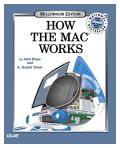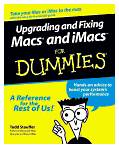It’s a good time to be reading about (and writing about) Macs. After the slow years of 1996 and 1997, we’ve seen a trickle of Mac books turn into a respectable stream. Part of the stream is two books that got their start in the early 90s and have just been updated. Enough has changed in the Mac world to warrant extensive re-writing of both titles.
How the Mac Works

This is the third edition of John Rizzo and K. Daniel Clark’s How the Mac Works, Millenium Edition (HTMW, formerly How Macs Work). Don’t be put off by the publisher’s hype that the book is “the perfect source for those who prefer to learn visually.” HTMW is the best introduction to the inner workings of Macintosh, period.
You get an overview of each major aspect of Macintosh (for instance, hardware), and then a series of chapters on the specifics.
Particularly good: The sections on OS X, especially Quartz.
The book reaches a level of explanation you just don’t find in other Mac references. As good as John Rizzo’s writing is – and it’s very good – the secret here is the relationship between Rizzo’s words and Clark’s illustrations. The pictures don’t “dumb down” the book; they let Rizzo strike off into ever more complex areas without leaving his readers behind.
One caution: This book is mildly less useful to Low End Mac readers, because it focuses on the iMac and “colorful” G3s and G4s. That means some older technology (ADB, for instance) doesn’t get the full treatment. Also, System 7 coverage is gone.
Personally, I liked learning about the new stuff. But if you want full coverage of clone-era Macs, look for the previous edition, How Macs Work, Bestseller (1996) Edition, which is still available in some stores and online.
One thing How The Mac Works is not: It is not a troubleshooting guide.
Upgrading and Fixing Macs and iMacs for Dummies
For that, you could turn to Todd Stauffer’s Upgrading and Fixing Macs and iMacs for Dummies. I suppose this is  technically an update to a much older edition of Upgrading, but that book is so old (and was written by two other people) that you might as well regard this version as a brand new book.
technically an update to a much older edition of Upgrading, but that book is so old (and was written by two other people) that you might as well regard this version as a brand new book.
Stauffer is the author of the Macworld Mac Upgrade and Repair Bible (now in its second edition), of which this book is a “greatest hits.” Stauffer is a companionable writer, and Upgrading is a pleasant read that doesn’t try too hard to fit the “Dummies” mold.
My only question is, who will buy it? Repair gurus are almost certain to own the Macworld volume (updated Sept. 2000), so they don’t need this book. And frankly, the book is – unavoidably – just technical enough to keep many other Mac users at bay.
Oh well. It’s a great cookbook for diagnosing hardware and software troubles, and the kind of book you want in arm’s reach when you don’t have the time or patience to hit one of the thicker Mac tomes. Plus, it’s a bargain at $19.99.
In particular, I recommend Upgrading for LEM readers. It has enough about the older technologies to make it a worthy investment, even if your newest machine is a 6100.
Short link: http://goo.gl/gOf2jz
searchword: insideyourmac

